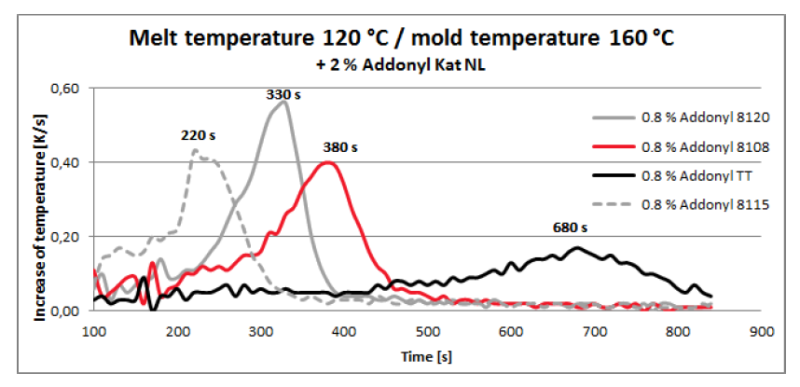Enhanced TDS
Identification & Functionality
- Function
- Activator
- Plastics & Elastomers Functions
- Product Code
- MITM09324
- Technologies
- Product Families
Features & Benefits
- Materials Features
Applications & Uses
- Compatible Polymers & Resins
- Markets
- Applications
- Processing Information
- Processing temperatures:
- Melt: 110-130 °C
- Mold: 130-160 °C
- Recommended Dosage: 0.5-0.7 % by weight
- The following diagram shows the reactivity of various Addonyl activators, with the same weight dosing, subject to time:
-
- Processing temperatures:
- Application Information
- Addonyl® 8108 is used as an activator during the production of Cast Nylon (PA-6 G). In combination with the catalyst Addonyl® Kat NL
- Use
- The reactivity of the polymerizing melt is influenced by various factors. Recommended an activator concentration of at least 0.5 % by weight. The quantity of the activator to be used, however, decisively depends on the size and form of the casting mold. Addonyl® 8108 is easily soluble in molten caprolactam. The caprolactam melt containing the activator is susceptible to oxidation. Thus, we recommend working under inert gas.
Properties
- Physical Form
- Soluble In
Safety & Health
- Safety Precautions
A receiving inspection is recommended. In moist conditions, with the formation of carbondioxide, Addonyl® 8108 converts to a solid, high-melting and insoluble polyurea.
Packaging & Availability
- Packaging Type
Principal Information
- Group Principal Number
- S000008
- Principal
Storage & Handling
- Storage and Handling Conditions
- Addonyl® 8108 has a shelf life of at least 24 months if handled correctly. The product may occasionally turn reddish during storage.
- Heat sensitivity: starting from + 50°C
- Frost sensitivity: starting from - 10°C
- Keep containers dry and tightly sealed.
- Addonyl® 8108 has a shelf life of at least 24 months if handled correctly. The product may occasionally turn reddish during storage.
Other
- Appearance
- Yellowish liquid which may occassionally tend to a redish color during storage with a weak solvent - type odor
- Color (SDS)
- Yellow
- Item Number
- Odor (SDS)
- Solvent like
- Temperature Control
- Yes
- USA/DOT UN Number
- Not Applicable
- Application Information
Value Units Test Method / Conditions Dosage (Use Level) 0.5-0.7 %(W/W) %(W/W) - Material Composition
Value Units Test Method / Conditions Isocyanate Group Content 15.0-17.0 % % - Physical Properties
Value Units Test Method / Conditions Density 1.082 g/cm³ g/cm³ at 20°C Storage Temperature max. 122.0 °F °F Viscosity 100.0 mPa.s mPa.s at 23°C - SDS Physical and Chemical Properties
Value Units Test Method / Conditions Boiling Point (SDS) 210.0 °C °C At 1013 Hpa Decomposition Temperature (SDS) min. 300.0 °C °C Density (SDS) 1.082 g/cm³ g/cm³ Explosion Limit (SDS) 1.3-7.7 % % Flash Point (SDS) 136.0 °C °C Closed Cup Flash Point (SDS) 136.0 °C °C DIN ISO 2592 Ignition Temperature (SDS) 245.0 °C °C Kinematic Viscosity (SDS) 0.021 cm²/s cm²/s Vapor Pressure (SDS) 0.18 hPa hPa at 20°C Viscosity (SDS) 100.0 mPa.s mPa.s - Shelf Life & Stability
Value Units Test Method / Conditions Shelf Life 24.0 mo mo

